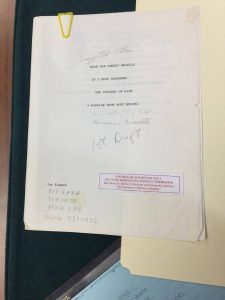Dear Reader,
Last week our ASTU class was a little unusual, because we went on a class outing. Can you guess where we went? To a library of course! Not any library, however, but the Rare Book and Special Collections in Irving K. Barber Learning Centre. When Professor Luger announced this location for our outing, I was undeniably intrigued. Rare Books and Special Collections. Does it not sound like a name taken straight from J.K Rowling’s Happy Potter novels? Can it really be that exciting? Actually, it gets even better. Not only the name is taken out of a magical novel, but the whole sensation of the library itself, both in terms of the location and the material within it. My appreciation of the relevance and power of libraries was definitely altered after I entered this mysterious and hidden library in the basement of Irving.
Meeting us at the door, in the beginning of this journey into what the library has to offer, was a librarian greeting us with a warm smile. Escorted to a lecture room at the back of the library, we were given a short introduction about the resources provided by the library and given a couple of exercises to complete during our visit. Apparently, this small library has gathered a remarkable number of collections of unique archival materials, rare books and collections of various artefacts. Indeed, what is rather impressive about this library in particular is that many of the collected items and primary sources can only be found there and not anywhere else. This unique material varies from objects such as a bible from the 1400 to a collection of several copies of Alice in Wonderland. This means that it serves an important function for unique research opportunities for scholars, by giving them access to sources of information with the power to give a unique insight to their research.
For the purpose of our visit, we were given archives belonging to Joy Kogawa from the time when she was writing the novel Obasan that we read and studied in class. When analysing different pieces from the archive the class was divided into pairs, each pair given a specific piece to examine. The piece my classmate and I were given was three extracts from some of the earlier drafts of the novel. Particularly captivating was one document that presented alternative titles Kogawa had in mind for the novel. Some of these titles were “If I Must Remember” and “The Colours of Rain”, which I personally feel resonate a lot better with the story told in Obasan. Knowing these alternative titles it is impossible not to imagine the “what if”. I found it strange to think how different it would have been if one of these titles had been chosen instead of Obasan. To formulate the emotional response this knowledge catalysed in me I would use the metaphor of hearing about the partners your mother had before she met your dad. There is strange paradigm shift that occurs when your perception of something that you took for granted is shown that it easily could have been something very different.
So why did Kogawa choose “Obasan” instead of the other? From a more scholarly speaking perspective, to have the ability to ask this question is fascinating for several reasons. First, it tells us about the thought process behind the creation of the novel, which indirectly may suggest Kogawa’s intention. For instance, the title “If I Must Remember” goes well along with the theme of reluctant remembrance portrayed in through the story. Given this archival material one could argue that Kogawa tells the story about the Japanese Internment not because she wishes to, but because she felt the need to share it. On the other hand, one could also argue for the opposite. The archival material with alternative titles could equally suggest that it is impossible to determine an author’s real intention, because of these constant changes between the different drafts of a novel. Thus, having access to this information opens up another level of analysis that goes way beyond what the novel can provide alone.
It is truly fascinating what a simple piece of information can change how you look at something. I will for certain come back and explore the library another time.
Have a nice week!

